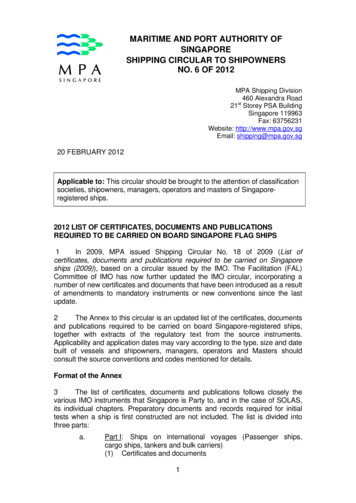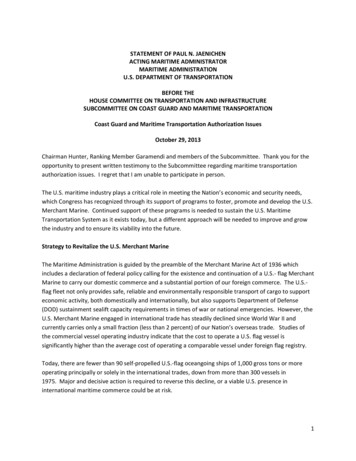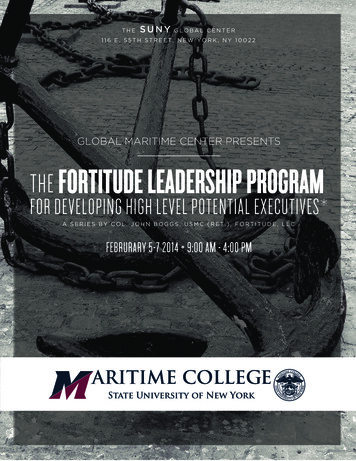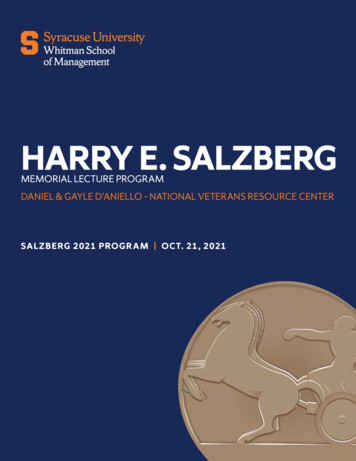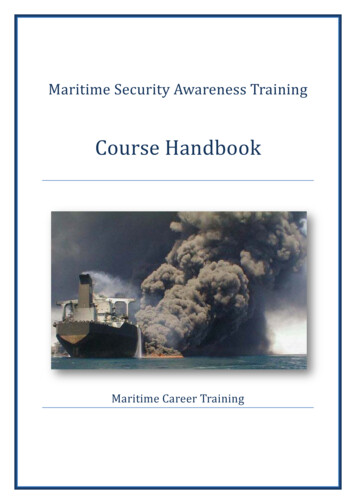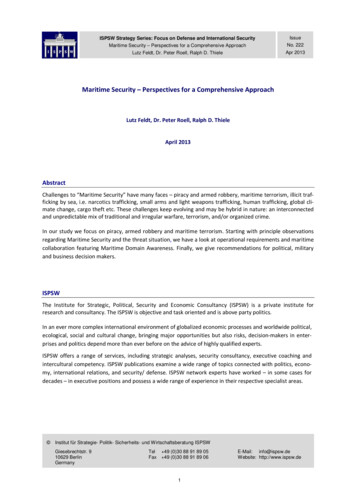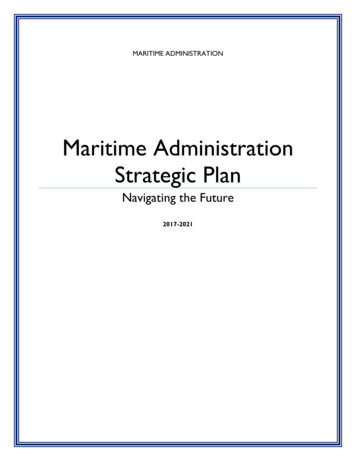
Transcription
MARITIME ADMINISTRATIONMaritime AdministrationStrategic PlanNavigating the Future2017-2021
Table of ContentsMESSAGE FROM THE EXECUTIVE DIRECTOR, IN LIEU OF THE MARITIMEADMINISTRATOR.5THE MARITIME ADMINISTRATION MISSION AND VISION . 7ABOUT THE MARITIME ADMINISTRATION . 8THE STRATEGIC PLAN .11DOT STRATEGIC PLAN (2014-2018) . 11MARAD STRATEGIC GOALS. 11RELATIONSHIP BETWEEN DOT AND MARAD GOALS. 12MEETING THE GOALS .14STRATEGIC GOAL 1: SUPPORT U.S. MARITIME CAPABILITIES. 14Objective 1.1 Secure maximum preference cargo for U.S.-flag vessels. . 16Objective 1.2 Seek to reduce U.S.-Flag operating costs. . 16Objective 1.3 Improve support programs for domestic shipbuilding/repair capability. 16Objective 1.4 Continue to ensure ready availability of ships, training billets, crews, andstrategic ports. . 16STRATEGIC GOAL 2: MAINTAIN AND MODERNIZE THE MARITIME WORKFORCE . 17Objective 2.1 Ensure that U.S. mariner requirements for economic and national securityare identified and met. . 18Objective 2.2 Modernize the USMMA and SMA school ships, training and educationfacilities or facilitate other suitable alternative training opportunities that meetinternational requirements. . 18Objective 2.3 Standardize certification of shipyard job types to promote labor mobilityamong shipyards. 18Objective 2.4 Facilitate an educational and workplace environment that is unbiased andsafe from sexual harassment and sexual assault, as well as any other discriminatorypractices or behavior . 18Objective 2.5 Engage the K-12 and post-secondary (non-maritime academy) institutions topromote Science, Technology, Engineering and Math (STEM) education and maritimecareer opportunities . 181
STRATEGIC GOAL 3: IMPROVE, EXPAND AND PROTECT WATERBORNETRANSPORTATION . 19Objective 3.1 Leverage DOT funding and financial resources to assist in reducing nationallandside port congestion. . 20Objective 3.2 Establish marine highway services to certain congested large urban portareas and along major freight corridors. . 20Objective 3.3 Leverage DOT resources to enable additional U.S. ports to have landsidefacilities that can accommodate fully-loaded containerships of up to 24,000 TEU capacity. 21Objective 3.4 Leverage DOT resources to enable additional U.S. ports to have landsidefacilities that can accommodate fully-loaded containerships of up to 16,000 TEU capacity. 21Objective 3.5 Leverage DOT resources to enable additional U.S. ports to have landsidefacilities that can accommodate dry bulk and tanker vessels of 50 feet in draft. . 21STRATEGIC GOAL 4: MINIMIZE ENVIRONMENTAL IMPACTS . 22Objective 4.1 Collaborate with public and private entities to expand carriage of cargo bywater, to reduce pollution and congestion in other transportation modes. . 23Objective 4.2 Support research, testing and innovation to enable ports to minimize theirenvironmental footprint through improved technology and practices. . 23Objective 4.3 Support research, development and demonstration of alternative non-carbonenergy sources and cleaner burning carbon based fuels and technology that will enhancevessel energy efficiency, reduce pollution and lower costs. . 23Objective 4.4 Dispose of government-owned merchant-type ships in an efficient andenvironmentally responsible manner in domestic shipyards. . 23STRATEGIC GOAL 5: MARITIME INNOVATION. 24Objective 5.1 Leverage existing ITS technologies and innovations and applications tobenefit maritime/intermodal transportation. . 24Objective 5.2 Leverage technologies to improve information flow for secure door-to-doortracking of cargoes including movements of cargoes on vessels, through ports, and onconnecting surface transportations systems. 24Objective 5.3 Leverage the development of innovative ship designs and business processessuitable for U.S. domestic carriers and shipyards. . 24Objective 5.4: Sustain progress in research, innovation, and deployment, includingadvanced technology for automation, ship design, shipyards, ports, and carriers. . 24Objective 5.5: Position the USMMA as a leader and partner in maritime research andinnovation. . 252
STRATEGIC GOAL 6: ORGANIZATIONAL EXCELLENCE . 26Objective 6.1 Maintain and improve a talented, dedicated, and diverse workforce thatensures that MARAD personnel remain well-trained, engaged and committed toachievement of the agency’s annual and long term performance targets. . 26Objective 6.2 Maintain effective and efficient administrative support to meet DOT andMARAD strategic priorities and leadership imperatives. . 26Objective 6.3 Ensure execution of MARAD’s and the USMMA’s IT Strategic Plans andEnterprise Architecture Transition Strategy and meet Federal Enterprise Architecture andother Federal mandates. . 273
ACRONYMS USED IN THIS DOCUMENTCRFCCFCMTSDODDOTESAFAST EARR&DRRFSMAsTEUTIGERTitle XITRBUSMMAUSCGVISACapital Construction FundConstruction Reserve FundCommittee on the Marine Transportation SystemDepartment of DefenseDepartment of TransportationEndangered Species ActFixing America's Surface Transportation Act of 2015Fostering Advancements in Shipping and Transportation for theLong-term Achievement of National EfficienciesInternational Maritime OrganizationInternational Organization for StandardizationIntelligent Transportation System Joint Program OfficeMaritime AdministrationMaritime Environmental and Technical AssistanceMaritime Security ProgramMarine Transportation SystemMarine Transportation System National Advisory CouncilNational Defense Reserve FleetPosition Enrichment and RealignmentResearch and DevelopmentReady Reserve ForceState Maritime AcademiesTwenty-foot equivalent unitTransportation Investment Generating Economic RecoveryMaritime Guaranteed Loan ProgramTransportation Research BoardUnited States Merchant Marine AcademyUnited States Coast GuardVoluntary Intermodal Sealift Agreement4
MESSAGE FROM THE MARITIME ADMINISTRATORI am pleased to present the Maritime Administration Strategic Plan for fiscal years 2017-2021.This Plan identifies the priorities and expected accomplishments of the Maritime Administration(MARAD) during a time of significant challenges and opportunities for the Agency, the maritimeindustry and the United States maritime transportation system.MARAD is the only agency in the Department of Transportation that was created specifically toperform a national security mission. By law, and by Presidential directive, the U.S. military mustrely on American mariners and the American commercial fleet, to meet our national defenseneeds. MARAD is charged with ensuring that the U.S. merchant marine – vessels and mariners– is large enough to meet the military’s requirements.Our mission is to improve, strengthen and promote the U.S. maritime transportation system tomeet the economic, environmental and security needs of the Nation. In our work across theGovernment and the U.S. maritime industry, we support and advocate advancements in thebusiness of shipping and maritime transportation, both domestically and internationally.MARAD is responsible for ensuring that the U.S. maritime transportation system is up to thetask of meeting these needs, now and in the future. The U.S. maritime transportation systemcontinues to face significant challenges due to aging ships and infrastructure, and foreigncompetition making it difficult to retain the resources that meet the needs of our country.The maritime transportation system of the United States—including waterbornetransportation, landside infrastructure, the shipbuilding and repair industry, and labor—integrates our economy with a vast global network of systems that moves more than 90percent of world trade tonnage, including consumer goods, agricultural products, energy andraw materials. 1 Of the goods that the U.S. imports and exports, approximately 72 percent byweight and 44 percent by value move by water transportation and through our national portsystem. 2To meet the National policy mandate, our programs and advocacy of the U.S. maritime industryare founded on the broad objectives of education, jobs, economic competitiveness, safety, andenvironmental sustainability. MARAD programs encompass cargo development, internationaland domestic trading vessels, sealift and national security, the maritime workforce, ports andintermodal infrastructure, shipbuilding and ship repair, and maritime operational solutions.These programs are linked to help assure the National policy goal of a healthy U.S. maritimetransportation system to support the Nation’s economic and national security.From around the country at our Gateway Offices, the U.S. Merchant Marine Academy, theReady Reserve Force sites, and at our Headquarters, our workforce fully embraces its1Source: United Nations, International Maritime Organization. https://business.un.org/en/entities/13DOT/Bureau of Transportation Statistics, Freight Facts and Figures 2015, Figure 2-9 U.S. InternationalMerchandise Trade Value and Weight by Transportation Mode: v.bts/files/data and statistics/by subject/freight/freight facts 2015/chapter2/fig2 925
commitment to our mission and to our Strategic Plan goals. It is through our workforce’sdedicated and determined commitment to organizational excellence that we will accomplishthese vitally important goals. By doing so, we will help to ensure the strength of the U.S.economy, ensure our national security and readiness, achieve environmental sustainability,create new jobs, and inspire and educate the next generation of mariners.JOEL SZABATExecutive Directorin lieu of the Administrator6
THE MARITIME ADMINISTRATION MISSION AND VISIONMISSIONTo foster and promote the U.S. Merchant Marine and the American maritime industryto strengthen the maritime transportation system – including landside infrastructure, theshipbuilding and repair industry, and labor – to meet the economic and national securityneeds of our nation.The Maritime Administration (MARAD) is charged with carrying out the National policiesestablished by the Merchant Marine Act of 1936 (1936 Act), as amended, which provide for theU.S. government’s support of the merchant marine. 3 This statute declares it necessary for thenational defense and the development of the domestic and foreign commerce of the UnitedStates to have a merchant marine:(1) sufficient to carry the waterborne domestic commerce and a substantial part of thewaterborne export and import foreign commerce of the United States and to provideshipping service essential for maintaining the flow of the waterborne domestic and foreigncommerce at all times;(2) capable of serving as a naval and military auxiliary in time of war or national emergency;(3) owned and operated as vessels of the United States by citizens of the United States;(4) composed of the best-equipped, safest, and most suitable types of vessels constructedin the United States and manned with a trained and efficient citizen personnel; and(5) supplemented by efficient facilities for building and repairing vessels.For this reason, Congress declares in the statute that “It is the policy of the United States toencourage and aid the development and maintenance of a merchant marine satisfying the objectivesdescribed.”Since 1775, the marine transportation industry has met the needs of our Nation during times ofpeace and war. The U.S.-flag fleet, the maritime workforce, seaports and the nation’sshipbuilding and repair capability continue to be critical components of the transportationinfrastructure and military readiness.VISIONAn innovative, competitive U.S. maritime system that enhances our Nation’s multimodalmobility and ensures our national and economic security in an increasingly globalizedworld.346 U.S. Code § 501017
ABOUT THE MARITIME ADMINISTRATIONMARAD is the agency within the U.S. Department of Transportation (DOT) that supports theUnited States maritime industry. Its programs promote the use of waterborne transportation,and its seamless integration with other modal components of the transportation system, andthe viability of the U.S. Merchant Marine.Commercial mariners, vessels, and intermodal facilities are vital for supporting national andeconomic security. MARAD is charged with maintaining the health of all U.S. maritime industrycomponents, including ships and shipping, the U.S. Merchant Marine, shipbuilding and repair,education and workforce development, landside port infrastructure, waterways and intermodalconnectors, maritime safety and security, environmental protection, port operations, vesseloperations and national security.MARAD also advocates for the maritime industry; manages assets in support of theDepartment of Defense (DOD), including maintaining a fleet of government-owned cargovessels; administers and funds the Maritime Security Program (MSP); operates the U.S.Merchant Marine Academy (USMMA) at Kings Point, NY; provides training ships, funding andother support for the six State Maritime Academies (SMA) (Maine, Massachusetts, New York,Texas, California and Michigan); and administers the Federal Ship Financing Program (Title XI). 4To encourage a strong U.S. Merchant Marine for both national defense and economic security,the Jones Act (46 U.S.C. § 55101) requires that cargo being transported by water between U.S.points must travel in U.S.-built and U.S.-citizen owned and crewed vessels that are registered inthe United States. MARAD strongly supports the Jones Act, the U.S. commercial fleet, and thehighly trained mariners who crew those vessels.As an advocacy organization, MARAD works with many valued partners including other Federalgovernment agencies, port authorities, state, local and regional transportation planningorganizations, schools and maritime academies, and others that own and operate keytransportation infrastructure or provide transportation services. Other agencies of the Federalgovernment have diverse responsibilities for maintaining infrastructure- such as navigationchannels, shipping lanes, locks, and inland and other waterways. Our strategy seeks tostrengthen coordination among government agencies and between the U.S. maritime industryand international organizations. Many of these organizations provide a service, capability, orrequirement relevant to MARAD’s mission, which necessitates strong partnerships as a vitalfactor to our success.4The Federal Ship Financing Program (commonly referred to as Title XI) was established by the Merchant MarineAct of 1936 (46 U.S.C. Chapter 537) and provides for a full faith and credit guarantee by the U.S. Government topromote the growth and modernization of the U.S. Merchant Marine and U.S. shipyards.8
CHALLENGES FACING THE U.S. MARITIME INDUSTRYThe U.S. maritime industry, including operating companies, ports and waterways, shipbuilding,and maritime jobs has not kept pace in recent years with advances in global trade andtechnology. Even though the United States is the world’s largest trading nation, growth inglobal trade has outpaced the ability of the U.S. maritime industry to efficiently meet increasingdemand.To meet the current and future needs of the Nation, the U.S. maritime industry and MARADmust address a host of challenges. These include: Maintaining U.S.-flag ships in international trade,Ensuring that ports and related infrastructure can accommodate the largest vesselsoperating in global trade,Maintaining a supply of qualified merchant marines to crew reserve ships for defense andemergency sealift,Maintaining capacity to build and repair large ships,Mitigating maritime transportation impact on the environment and communities,Supporting innovative and clean technology for ports and vessels, andEnsuring that MARAD can effectively carry on its mission into the future.Advocate for adequate landside and waterway infrastructure to support our nation’sfuture maritime transportation needs.To carry out its mission and statutory responsibilities, MARAD provides expert technical andprofessional skills for a variety of programs, including national security planning and operations,cargo movement, environmental compliance, safety, maritime security, vessel design andconstruction, infrastructure development, international and domestic vessel operations, andmaritime finance. These programs are intended to foster a strong merchant marine, Americanjobs, and investment in the maritime transportation infrastructure. To meet these needs,MARAD has prepared this Strategic Plan with broad strategic goals, and strategic objectives toattain these goals.In coordination with other DOT modes, MARAD addresses the most pressing issues facing themaritime transportation system, including the need for expanding the capacity of our Nation’sseaports, landside infrastructure, and intermodal connections to accommodate larger ships andincreased cargo volume. DOT/MARAD also mediates competing interests for transportationinvestments, forges working partnerships with both industry and other government agencies (atthe Federal, State and local level), and administers Federal maritime related grants supportingTransportation Investment Generating Economic Recovery (TIGER), Fostering Advancementsin Shipping and Transportation for the Long-term Achievement of National Efficiencies(FASTLANE), and America’s Marine Highway projects.The availability of a sufficient number of qualified U.S. mariners is a growing concern. In timesof national emergency, mariners are needed on short notice to crew U.S. government-ownedships, while also maintaining domestic and international maritime commerce that is the lifeblood9
of the U.S. economy. With the declining number of oceangoing ships in the U.S.-flag fleet, thesupply of readily available qualified mariners is correspondingly in decline. This criticallyimportant issue is addressed in the Maritime Workforce Strategic Goal.Stipends paid under the MSP and U.S.-flag carrier access to government-impelled preferencecargoes serve to help compensate carriers for the operating cost differential between U.S.-flagand foreign-flag vessels. Most of the U.S.-flag ships operating in international trades receive astipend under the MSP or rely on preference cargoes to remain profitable. Although the MSPstipend has been increased to cover inflation in recent years, reductions in Department ofDefense (DOD) and other preference cargoes since 2012, and increasing operating costs, havecaused many non-MSP ships to leave the U.S.-flag fleet.The shipbuilding and repair industry is a vital part of this country’s transportation system and ispart of the strong industrial base that assists in meeting the DOD and Department ofHomeland Security (U.S. Coast Guard (USCG)) shipbuilding and repair requirements. A recentMARAD economic study shows that shipbuilding activity extends to all 50 states, from vendorand supplier contributions to actual shipbuilding and repair operations. 5 Although no new largeoceangoing vessels for the international trades have been built in U.S. shipyards for more thantwo decades, U.S. shipyards are constructing limited numbers of state-of-the-art commercialvessels for domestic use. U.S. shipyards currently produce fewer than 5 large self-propelledcommercial vessels per year, relative to world production of 1,440 such ships per year. TheU.S. production rate is expected to continue this decline as demand for tanker construction islikely to fall off over the next decade.The ability to sustain commercial shipbuilding is critical to the Nation’s ability to expandproduction during national emergencies. In addition to adequate shipbuilding infrastructure, itis imperative to maintain a skilled shipyard labor force, which has regrettably declined in recentyears due to U.S. shipyard closures, a decline in the U.S. vender base, and low-cost internationalcompetition.5Maritime Administration, The Economic Importance of the U.S. Shipbuilding and Repairing Industry, November 2015.10
THE STRATEGIC PLANAs an operating administration within DOT, MARAD’s strategic goals are aligned with theDepartment’s strategic goals. A primary MARAD responsibility within DOT is to support anddevelop the Nation’s maritime transportation system so that it can move sufficient foreign anddomestic commerce to accommodate economic growth, and provide military sealift andhumanitarian aid response during national emergencies. MARAD also connects with maritimeindustry stakeholders and partners to help support, advocate for, and focus public/privateinfrastructure investments on the national freight network and on multi-modal freightcorridors.DOT STRATEGIC PLAN (2014-2018)The Department of Transportation Strategic Plan sets the direction for DOT to provide safe,efficient, convenient and sustainable transportation choices through five Strategic Goals; Safety –Improve public health and safety by reducing transportation-related fatalitiesand injuries for all users working toward no fatalities across all modes of travel;State of Good Repair – Ensure the U.S. proactively maintains critical transportationinfrastructure in a state of good repair;Economic Competitiveness – Promote transportation policies and investments thatcreate ladders of opportunity, support strong communities, and bring lasting andequitable economic benefits to the Nation and its citizens;Quality of Life in Communities – Foster quality of life in communities by integratingtransportation policies, plans, and investments with coordinated housing and economicdevelopment policies to increase transportation choices and access to transportationservice for all; andEnvironmental Sustainability – Advance environmentally sustainable policies andinvestments that reduce carbon and other harmful emissions from transportationsources, reduce our nation's dependence on foreign oil, improve air quality, andpromote public health.In addition to the five mission-aligned strategic goals listed above, DOT also includes othergoals for Organizational Excellence, Security, Preparedness, and Other SupportingObjectives.MARAD STRATEGIC GOALSTo support accomplishment of the DOT Strategic Goals and to achieve the MARAD mission insupport of the U.S. maritime transportation system, the following MARAD Strategic Goals areestablished:1. Support U.S. Maritime Capabilities - strengthen and ensure the safety, security,and efficiency of maritime capabilities that are essential to U.S. economic and nationalsecurity.11
2. Maintain and Modernize the Maritime workforce – inspire, educate, and expandopportunities for the next generation of mariners, including maximizing the potential of theUSMMA.3. Improve, Expand, and Protect Waterborne transportation – improve andexpand waterborne transportation to reduce landside congestion and increase mobilitythroughout the domestic transportation system and expand capacity of U.S.international gateway ports. Protect maritime and other transportation infrastructurefrom the growing adverse impacts of a changing climate.4. Environmental Impacts – minimize adverse environmental impacts and maximize thepublic benefits of water transportation on communities.5. Maritime innovation – drive innovation in the U.S. maritime industry.6. Organizational Excellence – in parallel with the Department’s goals, MARADembraces Organizational Excellence through strong leadership and workforcedevelopment within available resources.The following table shows the relationship between the Maritime Administration’s andDepartment of Transportation’s goals.RELATIONSHIP BETWEEN DOT AND MARAD GOALSSTRATEGIC RELATIONSHIP BETWEEN THE DEPARTMENT OF TRANSPORTATIONAND MARITIME ADMINISTRATION GOALSMARADDOTSupport U.S. Maritime Capabilities Safety –Improve public health and safety by reducingstrengthen safe, secure, and efficient maritimetransportation-related fatalities and injuries for allcapabilities that are essential to economic andusers working toward no fatalities across all modes ofnational security.travel.Maritime workforce – inspire, educate, andexpand opportunities for the next generationof mariners, including maximizing the potentialof the USMMA.Improve, Expand and ProtectWaterborne transportation – improveand expand waterborne transportation toreduce congestion and increase mobilitythroughout the domestic transportationsystem and expand capacity of U.S.international gateway ports. ProtectNote: DOT does not have a specific strategic goal forsecurity, but includes it as a supporting goal.State of Good Repair – Ensure the U.S. proactivelymaintains critical transportation infrastructure in astate of good repair.maritime and other transportationinfrastructure from the growing adverseimpacts of a changing climate.12
Support U.S. Maritime Capabilities strengthen safe and efficient maritimecapabilities that are essential to economic andnational security.Maritime Workforce – inspire, educate, andexpand opportunities for the next generationof mariners, including maximizing the potentialof the USMMA .Economic Competitiveness – Promotetransportation policies and investments that createladders of opportunity, support strong communities,and bring lasting and equitable economic benefits tothe Nation and its citizens.Note: DOT does not have a specific strategic goal forsecurity, but includes it as a supporting goal.Improve and Expand WaterborneTransportation – improve and expandwaterborne transportation to reducecongestion and increase mobility throughoutthe domestic transportation system andexpand capacity of U.S. international gatewayports. Protect maritime and othertransportation infrastructure from thegrowing adverse impacts of a changingclimate.Maritime Innovation – drive innovation inthe U.S. maritime industry.Support U.S. Maritime Capabilities strengthen maritime capabilities that areessential to economic and national security,including maritime education.Environmental Impacts – minimize theadverse environmental impacts and maximizethe public benefits of water transportation oncommunities.Environmental Impacts – minimize theadverse environmental impacts and maximizethe public benefits of water transportation oncommunities.Organizational Excellence - Ensure thatMARAD and the USMMA is best achieving thegoals of the Department within availableresources.Quality of Life in Communities – Foster qualityof life in communities by integrating transportationpolicies, plans, and investments with coordinatedhousing and economic development policies toincrease transportation choices and access totransportation service for all.Note: DOT does not have a specific strategic goal forsecurity, but includes it as a supporting goal.Environmental Sustainability – Advanceenvironme
I am pleased to present the Maritime Administration Strategic Plan for fiscal years 2017-2021. This Plan identifies the priorities and expected accomplishments of the Maritime Administration (MARAD) during a time of significant challenges and opportunities for the Agency, the maritime industry and the United States maritime transportation system.
